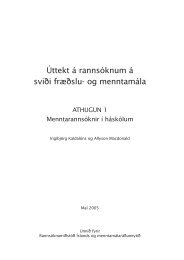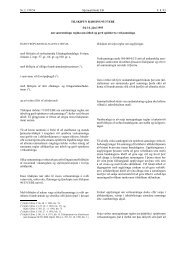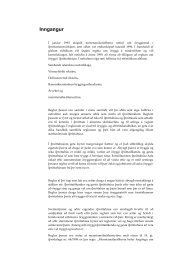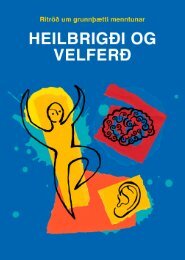Arts and Cultural Education in Iceland : Professor Anne Bamford
Arts and Cultural Education in Iceland : Professor Anne Bamford
Arts and Cultural Education in Iceland : Professor Anne Bamford
You also want an ePaper? Increase the reach of your titles
YUMPU automatically turns print PDFs into web optimized ePapers that Google loves.
have well-equipped specialist rooms for textile, woodcraft <strong>and</strong> computer design. There appears<br />
to be readily available arts resources such as pa<strong>in</strong>t <strong>and</strong> paper <strong>and</strong> musical <strong>in</strong>struments. In most<br />
schools, fundrais<strong>in</strong>g by parents supports arts programmes by provid<strong>in</strong>g such ‘extras’ as theatre<br />
or other visits <strong>and</strong> additional resources. None of the schools visited felt that they lacked<br />
adequate resources to deliver quality arts programmes, though some concern was expressed<br />
that this situation might change <strong>in</strong> the future.<br />
The upper secondary colleges visited were very well-resourced <strong>in</strong> terms of both rooms <strong>and</strong><br />
materials. While less common, some schools <strong>and</strong> colleges also had specialist dance <strong>and</strong> drama<br />
spaces. Music <strong>and</strong> other after school schools were also very well-equipped with high quality<br />
teach<strong>in</strong>g spaces <strong>and</strong> resources.<br />
Some schools have students’ art displayed <strong>in</strong> the classroom <strong>and</strong> <strong>in</strong> publicly accessible parts<br />
of the school, but the range <strong>and</strong> st<strong>and</strong>ard of these displays varied considerably. While particular<br />
schools have well-labelled <strong>and</strong> carefully presented, dynamic displays of pupils’ work, there is a<br />
general lack of emphasis given to public presentation. Public presentation of work is important<br />
as research suggests that pupils should be encouraged to produce more ‘resolved’, quality<br />
artworks <strong>and</strong> performances for public presentation. The lack of displays may have been<br />
<strong>in</strong>fluenced by the tim<strong>in</strong>g of the research, with some schools comment<strong>in</strong>g that work was<br />
removed over the holiday period, but this seems to not fully expla<strong>in</strong> the lack of presentation of<br />
pupils’ work.<br />
With a few notable exceptions, there is a lack of displays <strong>in</strong> <strong>and</strong> around schools of the pupils’<br />
achievements <strong>in</strong> the arts. It is a key factor to enhanc<strong>in</strong>g quality that work is displayed <strong>and</strong><br />
presented <strong>in</strong> a way that accords with professional st<strong>and</strong>ards <strong>in</strong> the field. For example, artworks<br />
should be mounted, labelled <strong>and</strong> hung with an awareness of the curatorial process. Display <strong>and</strong><br />
presentation should be a key element of textile, woodcraft <strong>and</strong> design courses. Even <strong>in</strong> schools<br />
that have clear spaces for exhibitions, these are rarely attractively used. For <strong>in</strong>stance <strong>in</strong> one<br />
school, children’s work from 2003 was still on display, despite its yellowed <strong>and</strong> unappeal<strong>in</strong>g<br />
appearance.<br />
There appears to be a trend <strong>in</strong> more recently built schools towards mak<strong>in</strong>g very flexible use<br />
of the school facilities. For example, schools may be designed around large shared spaces<br />
<strong>in</strong>stead of classrooms. Similarly, classes might be grouped to enable flexible <strong>and</strong> ‘team’ teach<strong>in</strong>g.<br />
Multi-age classes were also apparent. Teachers appeared to enjoy work<strong>in</strong>g flexibility. This had<br />
generally encouraged more creative learn<strong>in</strong>g, though a small but significant number of teachers<br />
felt that more ‘open’ classes may have actually decreased creativity as teachers work<strong>in</strong>g <strong>in</strong> more<br />
open rooms were concerned by “disturb<strong>in</strong>g other teachers” <strong>and</strong> felt “desk work” was “easier to<br />
manage” than creative work.<br />
28







![Aðalnámskrá tónlistarskóla : rytmÃsk tónlist [Eingöngu á rafrænu formi]](https://img.yumpu.com/50843672/1/184x260/aaalnamskra-tanlistarskala-rytma-sk-tanlist-eingangu-a-rafranu-formi.jpg?quality=85)









